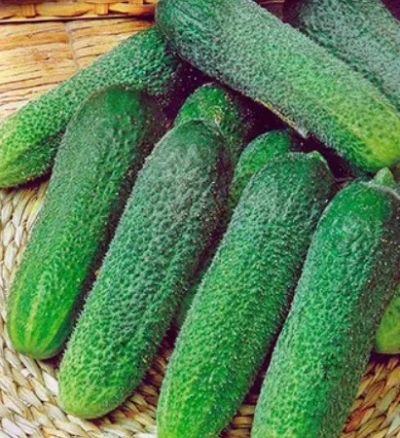
- Authors: Nunhems, Holland
- Growth type: indeterminate
- Branching: the average
- Fruit weight, g: 100
- Fruit color: green, with light stripes of medium length and slight mottling
- Cucumber Mosaic Virus Resistance: stable
- Ripening terms: early
- Fruit shape: cylindrical
- Fruit taste: excellent, no bitterness
- Appointment: for pickling and preserving, for fresh consumption
The Dolomite cucumber is a high-yielding variety that also attracts growers with its disease and pest resistance. Cucumber fruits can be easily found for universal use, as they are ideal for serving both fresh and processed.
Breeding history
Breeders from Holland were engaged in the breeding of the Dolomite variety. Through a series of experiments, scientists managed to obtain a plant that can bear fruit after 38-42 days. The cucumber quickly gained popularity and became in demand among gardeners.
Description of the variety
Main characteristics of Dolomite:
bush - open and moderately branched, of small height;
leaves are of medium size, rich green hue;
ovary - bundle type.
From 6 to 8 small cucumbers are formed in the bosom. The flower type is predominantly female.
Characteristics of the appearance of plants and zelents
Indeterminate bushes grow without any restrictions, forming fruits throughout the season. Characteristics of cucumbers:
deep green color;
white stripes;
thorns - white, small in size;
cylindrical shape;
length from 10 to 14 cm;
diameter from 3.5 to 4 cm.
With the right approach to cultivation, the average weight of one fruit reaches 100 g. The thin skin is quite dense, which increases the possibility of its transportation.
Purpose and taste of fruits
Dolomite cucumbers demonstrate excellent taste, do not taste bitter and have a pleasant pulp consistency. The fruits are suitable for consumption both fresh and as preparations: pickles, salads or snacks.
Maturation
Dolomite is a variety that belongs to the group of plants with an early ripening period, and this is one of its key features. From the moment the first shoots appear to the formation of fruits, no more than 40 days pass. Flowering begins towards the end of spring or early summer.
Yield
The variety shows a fairly high yield. With normal care, the plant produces an average of 5-6 kg per 1 m2. It is possible to collect up to 600 kg of fresh fruits from each hundred square meters per season.
Growing and caring
You can achieve a high yield of cucumber through a competent approach to cultivation. First of all, you should take care of the seed. Variety seeds:
sort;
soaked in a disinfecting solution;
germinate at home.
To grow Dolomite seedlings, you need to take into account several recommendations:
it is better to plant seeds in peat or plastic cups one at a time;
the maximum depth of planting seed in the ground should not exceed 2 cm;
after planting cucumbers, it is necessary to cover the seeds with fertile soil, and thoroughly moisten with a spray bottle.
Containers with seedlings should be kept in a warm and sunny place.
The transplanting of the Dolomite bushes that have hatched occurs about a month after the seed germination, when 4-7 leaves are formed on the seedling.The scheme for planting cucumbers in the ground or greenhouse is 50x50 cm, the depth should not be less than 6 cm. At the same time, gardeners advise pouring a small layer of organic fertilizers in the form of droppings or manure on the bottom of the hole. After planting for a couple of weeks, the seedlings are covered with foil.
Proper care will help you grow healthy cucumbers. Main steps.
Watering. It is necessary to bring moisture under the bushes every 2 days. If there is a drought, watering should be increased to 1 time per day, and during the rainy season, it should be reduced by about half. When adding moisture, you need to make sure that the water flows directly under the root and does not fall on the leaves and stems.
Loosening is carried out after each watering together with weeding. The procedure will allow the soil to be saturated with oxygen, and will also accelerate the delivery of nutrients to the cucumber fruit.
Top dressing. Fertilizers are applied to the soil about 5-6 times per season. Organics or complexes of mineral preparations are usually used as top dressing. And you can also prepare a solution from urea, superphosphate and potassium sulfate.
Closer to the formation of the fruit, cucumbers will need a garter. This can be done using pegs and thread. If curly stems are not tied up in time, the yield indicator will fall.

In order to collect strong, tasty and beautiful cucumbers on your site, you need to make top dressing. Lack of nutrients can negatively affect the appearance of the plant and significantly reduce the yield. Fertilize cucumbers with organic fertilizers in combination with mineral fertilizers. With the right balance of these components and adherence to the fertilizing schedule, the cucumber yield will be maximum.
Disease and pest resistance
Dolomite is distinguished by strong immunity, but this does not mean that it does not need protection from pests and diseases. Improper agricultural technology and non-compliance with the basic recommendations for watering and feeding will lead to the appearance of the following guests on the cucumbers:
powdery mildew;
root rot;
sprout fly.
To prevent an unwanted visit, you need to take care of carrying out preventive treatment with special compounds that can be bought at a garden store. If pests and diseases have already attacked the cucumber, it is necessary to remove the damaged stems, leaves or fruits in order to prevent the disease from spreading.

Despite their popularity, cucumbers are often attacked by diseases and pests. From them, cucumber plantings often die before the start of fruiting. In order to prevent this from happening, it is necessary to try to prevent ailments or get rid of them at the very beginning, having studied in detail their causes of occurrence, signs and methods of treatment.





























































































